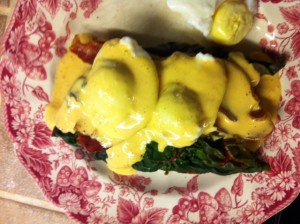After a great trip to New Orleans in October, 2012, I fell in love with Eggs Benedict. We found ourselves making repeat breakfast visits to Restaurant Stanley where I ordered the Eggs Benedict Poor Boy. And, Oh Boy, was it gooooood! After returning home, I decided we needed to find a way to make this at home. Now, if you know anything about eggs benedict and hollandaise sauce, you know that both the eggs and the sauce require a special technique to master properly (assuming you are not cheating with an egg poacher insert for your pan). Well, Mark found a great video showing a fairly fool-proof technique for making pretty poached eggs without the poacher pan insert. Now for the sauce. Well, good hollandaise sauce has a beautiful golden color and perfectly smooth, creamy texture. This perfection is difficult to achieve. Again, Mark saved the day by finding a great video for a fool-proof technique for making perfect hollandaise sauce. Now, why stop there when we have Sriracha in our refrigerator, which we consider to be an essential food group. So, we made the following recipe using the technique shown in the video linked above:
- 4 egg yolks
- 2T water
- 1T fresh lemon juice
- 2t Sriracha sauce
- pinch of salt
- black pepper
- 4T butter
We added all of the ingredients to the hand blender cup and melted the butter in a pan until it reached a temperature greater than 200F. Once the butter was ready, we added the butter to the blender cup as demonstrated in the video.
The assembly:
We decided to serve the eggs benedict over a slice of multi-grain toast with a piece of rainbow swiss chard. If we had english muffins in the house, I would have used them instead of regular toast. If you want to make the recipe paleo, omit the bread and use a bed of fresh greens instead. Spinach or kale would be my preferred substitute.
The result:
The dish turned out great! The Sriracha and swiss chard provided the perfect spice and earth balance to the sweet hollandaise sauce. The spice did not compete with the flavor of the sauce, but complemented it nicely. I may add an extra leaf of chard next time.
Technique tip:
I have two comments/modifications on the process:
(1) If you notice in the picture, there is a very lonely egg yolk just above the eggs benedict. I made 8 poached eggs (we are Fenner’s afterall). If you are going to make more than 3 or 4 eggs, you will need to clean your fine mesh strainer to unclog the pores. Otherwise, you last 3 or 4 eggs will not strain properly. This will result in ugly poached eggs. (of course they still taste good).
(2) It is very important that the poaching water does not get much above 180F. If it does, you will need to reduce your cooking time to closer to 3 minutes than 4, or your eggs will be more medium boiled than soft. And we all know that you want the runny eggs. Again, the first batch I did turned out perfect, but the water temperature rose to ~195F by time I did the second batch, which made them less runny.
(3) The video instructions emphasize the important of fresh eggs. I was initially worried because the eggs I had in the fridge were purchased over a week ago (wegman’s organic large brown eggs). Luckily there were only 2 eggs that were “old”.
